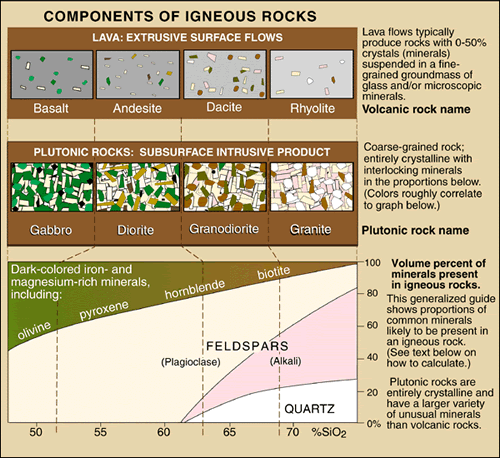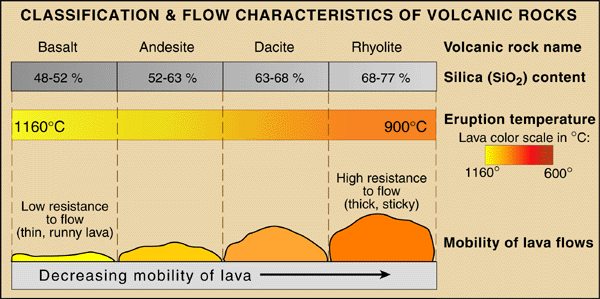Volcanic and Igneous Rock Types
Volcano Learning Zone > Volcanic and Igneous Rock Types
Volcanic rocks originate from igneous magma within the earths crust. Basalt,rhyolite and dacite are common lava types.When the magma is erupted onto the earths crust they then become extrusive or volcanic. Within the magma are the chemical ingredients to make minerals. The composition of the rocks above and below the surface is the same but mode of eruption and speed of cooling creates different a classification or rock type.
 High Silica magmas
High Silica magmas
Some magmas are rich in Silica,over 70%, these rocks make up a large proportion of the earths crust.They are typically light in colour,low density and contain quartz,feldspar and some mica.They are the granite family! Granite is the igneous rock but when erupted it becomes rhyolite.
Granite v Rhyolite
Lets look at Granite and Rhyolite.They have the same chemistry but granite is an igneous rock which has cooled slowly and the mineral crystals have been allowed to grow. Rhyolite lava is granite magma which has been erupted before lots of crystals have grown, its cools quickly once erupted and very small or no mineral crystals. There was no time for them to grow before the magma was erupted. There may be some larger crystals called phenocrysts which were in the magma and are now trapped in the fine gound mass of the volcanic rock. Rhyolites are commonly found in subduction zone settings where contamination of the rising magma by sediments and continental crust has given a high silica conent.
High Iron and Magnesium Magmas
Magmas rich in Fe amd Mg and with a lower Silica content, lower than 55%,form oceanic crust,shield volcanoes,rivers of lava and lava fountains. They contain Feldpars,pyroxene and olivine. You'll rarely find quartz in such a silica poor rock-but you never know! This is the Basalt family.
Gabbro v Basalt
Gabbro is the mams from which basaltic lavas originate. Gabbro magma chambers underly the mid ocean ridges and as the tectonic plates pull apart basaltic lavas erupt to create new oceanic crust. Gabbro is a crystalline rock which has clearly visible black (pyroxene/olivine) and white crystals(feldspar).Once erupted the magma melt cools to basalt. The original magma is derived from the mantle. Volcanoes which erupt basalts are in Hawaii and Etna.
Intermediate rocks
Magmas between Granite and Gabbro are known as intermediate and have a silica content between 525 and 68$ . This is where we find well known volcanic rocks such as Andesite and Dacite. A magma or melt as it cools in the magma chamber undergoes a process called fractional crystallisation. As the melt cools crystals form the more silica rich ones are less dense and float to the top the Fe/Mg minerals settle nearer the bottom . So you can have a more granitic melt at the top and more gabbroic one at the bottom. Add in convection currents to and a magma chamber is a real "cooking pot" of swirling and cooling crystals. Andesitic melts are named after the Andes and usually result in explosive eruptions.Dacite is a viscous lava which is extruded in domes,and can produce pyroclastic flows, as on Montserrat.
So how does all this affect lava?
Temperature and silica content are the two main factors contolling lava viscosity. Basalt erupts at around a 1000C and has a low silica content therefore it creates flowing rivers of lava. With increasing silica content, viscosity increases and the magma becomes more sticky. This means that gas bubbles cannot escape so easily and explosive eruptions are more likely.



